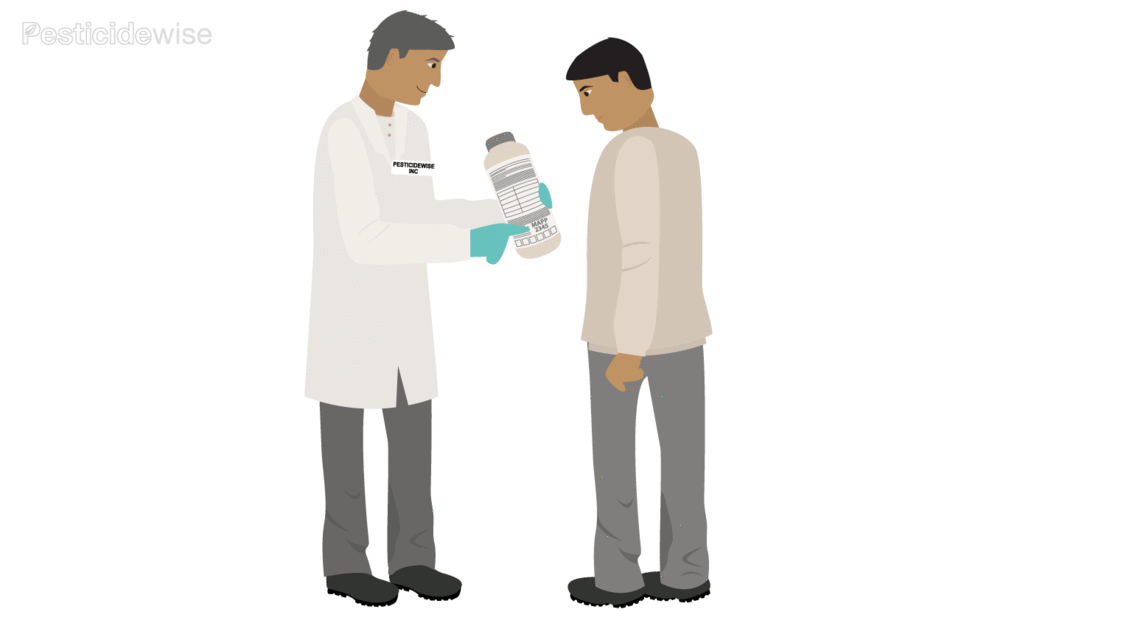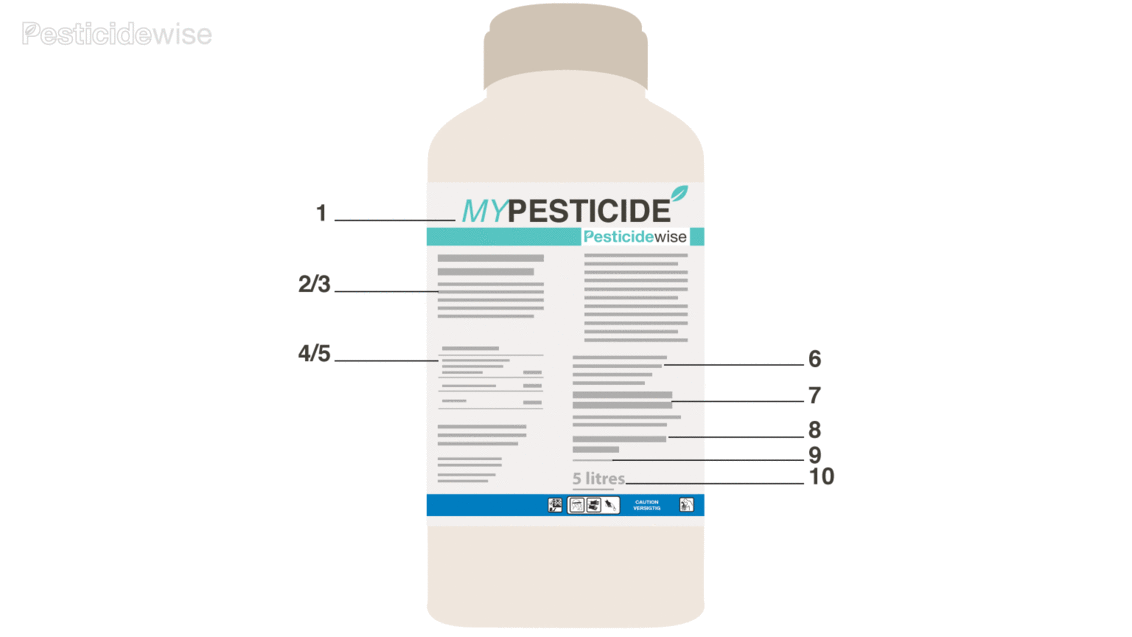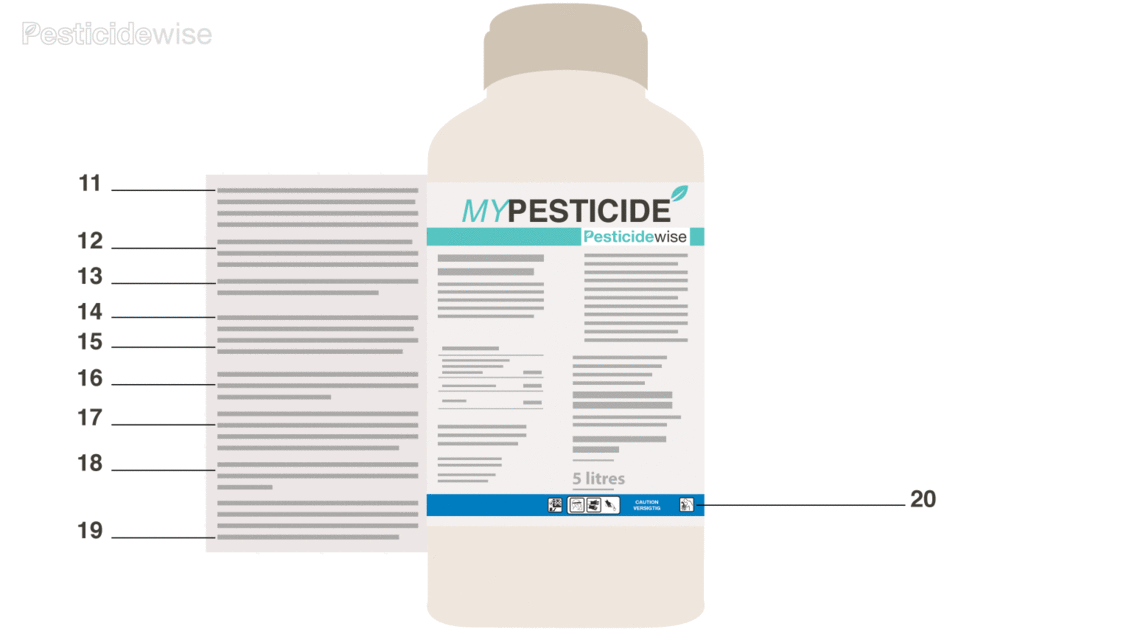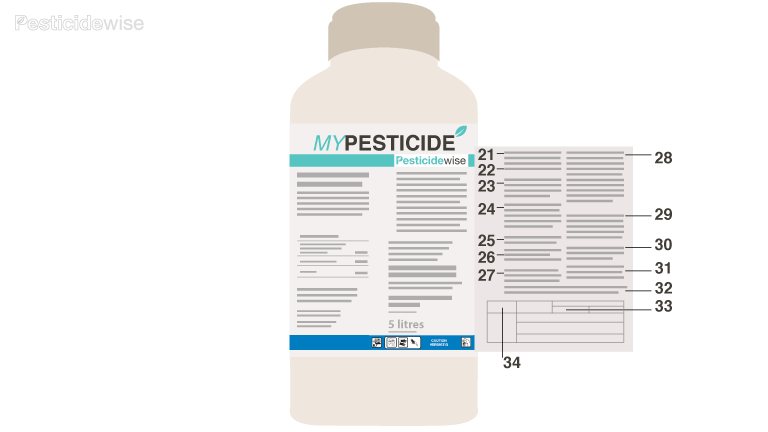Pesticide label
Your pesticide label is your key tool to solving your pest problem safely and effectively. Pesticides are designed to kill or control living pests (weeds, insects, pathogens, nematodes or rodents). Used badly, pesticides have the potential to harm people and animals, contaminate the water, soil and air. Follow the instructions on your pesticide label to protect yourself, your family, your neighbours, your land and those who consume your crops.
Understanding your pesticide label
add
remove

Pesticide labels can be complex. If you do not understand your pesticide label, ask a local, trusted expert to explain it to you.
Better pesticide labels conform to the FAO guidelines on Good Labelling Practice for Pesticides (668KB .pdf). Such labels tell you how to use your product in your country safely, and advise you:
- which pests will be prevented or controlled in which crops and the rate to use
- how to mix the product
- how and when to apply the pesticide safely
- when not to use it.
The guidelines also advise that your pesticide label provides data about the product itself: where and when it was made and who made it. Use this data to help you make sure that the product is genuine and fit for use. Your label should also give advice about safety; what to wear when mixing then using the product; how to store the product; how to dispose of pesticide waste; how to clean equipment; give warnings on safe use and first aid advice; and advice on good agricultural practices.
Remember: "A pesticide label is a legal document. It tells how the product should be used. It is against the law to use the product in any other way, or to use it in an unsafe way. It is also against the law for anyone to tell you that a pesticide can be used for anything that is not on the label." (BC Ministry of Agriculture).
Pesticide Label: About the product
add
remove

FAO recommends providing: | Label example: |
|---|---|
1. Product name | "TOUCHDOWN FORTE HITECH®" |
2. Formulation type The way the active ingredient(s) are combined to make a stable product. | "Soluble concentrate" |
3. Summary of uses Most common uses of the product. | "A soluble concentrate non-selective foliar, systemic herbicide with a wetting agent for use in glyphosate tolerant crops and for the control of a wide range of annual and perennial grasses, broadleaf weeds, certain woody perennials and industrial weed control." |
4. Common name An agreed, short name for the active ingredient. | "Glyphosate" |
5. Active ingredient statement The technical name of the chemical(s) that kills or controls the pest. | "Glyphosate" |
6. Name and address of manufacturer, distributor, agent or registrant The company responsible for this product in the country stated. | "Syngenta SA (Pty Ltd./(Edms) Bpk. (Co.MpyReg. No. 1998/013764/07) Private Bag/Privaatsak X60, HALFWAY HOUSE, 1685 RSA. Tel. (011) 541-4000" |
7. Registration number The unique number which identifies the product to regulators, manufacturers and poison control centres. | "Reg. Nr. L7305 Act/Wet No. 36 of /van 1947 N-AR 0625 Namibia" |
8. Date of Manufacture/ Formulation/ Batch Number Identifies when and where the product was made. | Since this is a sample label, a space was left at this position. |
9. Shelf life The length of time the product may be kept before use. | Since this is a sample label, a space was left at this position. |
10. Net contents (g) The amount of product in the container e.g. L, ml, kg, g. | Since this is a sample label, a space was left at this position. |
Pesticide Label: Safety information
add
remove

FAO recommends providing: | Label example: |
|---|---|
11. Product specific advice | "Flammable. Keep away from heat and flames." |
12. Good agricultural practice | "Do not transplant seedlings within 7 - 10 days after the last TOUCHDOWN FORTE HITECH® application." |
13. Relevant protective clothing precautions when handling the concentrate To protect the user when mixing the product. | "Wear rubber gloves and face shield when handling the concentrate. If you get it in your eyes, flush it out at once. If you get it on your skin, wash it off at once. If you spill it on your clothes, change and wash them." |
14. Precautions during and after application To protect the user, other crops and the environment. | "While spraying, avoid contact with the spray as much as you can. Avoid spray drift onto other crops, grazing, rivers or dams." |
15. Safe storage | "Store away from food, feed, fertilisers and other chemicals." |
16. Safe disposal of product Safe disposal of container. To avoid polluting the environment. | "Invert the empty container over the spray or mixing tank and allow to drain for at least 30 seconds after the flow has slowed down to a drip. Thereafter rinse the container three times with a volume of water equal to a minimum of 10 % of that of the container. Add the rinsings to the contents of the spray tank before destroying the container." "Destroy empty container and do not use for any other purpose." |
17. How to clean equipment if a potential risk exists To avoid the next crop being damaged or tainted with left-over pesticide. | "Clean applicator thoroughly after use and dispose of wash water where it will not contaminate crops, grazing, rivers or dams." |
18. Warnings | "Keep out of reach of children, uninformed persons and animals." "Transgenic and conventional crops: Care should be taken to reduce drift of TOUCHDOWN FORTE HITECH® to an absolute minimum. TOUCHDOWN FORTE HITECH® can cause serious damage to adjacent crops. This is especially important when TOUCHDOWN FORTE HITECH® is used on glyphosate tolerant crops with conventional crops adjacent or even in the vicinity." |
19. First aid advice/ medical treatment | "If you get it in your eyes, flush it out at once. If you get it on your skin, wash it off at once." |
20. Hazard classification The toxicity of the product and advice on the care to take when using the product. | "CAUTION" |
Pesticide Label: Using the product
add
remove

FAO recommends providing: | Label example: |
|---|---|
21. Directions for use; how when and where to apply the product When and where the product can be used legally. How to use the product to get the best effect; and safely to protect the crop, the user and the environment. | See items: 21, 22, 24 30 32 33. |
22. How to mix the product To get a stable spray mix of an even concentration. How the product should or could be mixed with other products. | "If [the additive] ammonium sulfate is required, it should be added to the spray water first of all. Agitate the water until the ammonium sulphate is dissolved. Then add the required quantity of TOUCHDOWN FORTE HITECH®. Ensure thorough agitation whilst mixing the spray mixture. Agitation must be continuous before and during spraying…" (continued) |
23. How to apply the product To get the spray deposit on target surfaces for best effect and least risk. | "….can be applied with conventional ground equipment (tractor mounted booms, knapsack, etc). Optimum spray deposits are obtained with ground equipment calibrated to spray 100 - 300 l/ha with suitable nozzles to ensure adequate coverage. Where drift is a problem do not exceed 2 bar. Use only the pressures recommended for specific nozzles to avoid drift… "(continued) "... ensure even droplet distribution on the green petal foliage. Spray run-off should be avoided..." (continued) "... All spray equipment must be properly calibrated and fitted with nozzles that deliver the correct volume of spray mixture, in order to reach the spray target whilst covering the target evenly with droplets..." (continued) |
24. Compatibility with other products Other products with which this product can and cannot be used. | "TOUCHDOWN FORTE HITECH® is compatible with CALLISTO® (L6795), DUAL GOLD® (L5749), METAGAN GOLD® (L5748), GARDOPRIM PLUS GOLD® (L7736), KARATE® (L3752), KARATE ZEON® (L6330), tebuthiuron and diuron. Consult the various labels for dosage rates, warnings and precautions..." (continued) |
25. Withholding period/re-entry period/pre-harvest interval The minimum number of days between the date of spraying and harvesting or entering the treated area. | "The minimum number of days between last application and harvest are: Maize – grazing ……. 28 days Greenmealies …….42 days..." (continued) |
26. General instructions for use | "Care should be taken of the general warnings and use directions on this label as it also applies to glyphosate tolerant crops. The weed spectrum in cotton, soybean and maize fields can differ due to…" (continued) |
27. Limitations of use (susceptible crops/varieties) Lists what the product will not control or particular cases where the product should not be used. | "TOUCHDOWN FORTE HITECH® can be applied on glyphosate tolerant cotton, soybean- and maize plants. Any individual plants that do not contain the glyphosate tolerant gene would die when sprayed with glyphosate based products e.g. TOUCHDOWN FORTE HITECH®. TOUCHDOWN FORTE HITECH® will not control volunteer glyphosate-tolerant crops..." (continued) |
28. Warning phrases and statements for Good Agricultural Practice Advice on how to protect the user, the consumer, the environment and by-standers. | "Do not eat drink or smoke whilst handling this product. Prevent contamination of food, feed, drinking water and eating utensils. Wear rubber gloves and face shield when handling the concentrate. If you get it in your eyes, flush it out at once. If you get it on your skin, wash it off at once. If you spill it on your clothes, change and wash them..." (continued) |
29. How to avoid harming beneficial insects or wildlife | No advice given on this example. |
30. Limitations of use (weather conditions) Weather that may affect the product's performance. | "Rain or irrigation within 3 hours of application can reduce the efficacy of TOUCHDOWN FORTE HITECH®. Do not spray on weed foliage covered with a layer of dust. In these situations apply after recent rain. Do not apply TOUCHDOWN FORTE HITECH® to weeds that are covered with dew, or in a dormant growth phase or under stress conditions e.g. moisture, heat or cold stress. Do not apply TOUCHDOWN FORTE HITECH® when the atmospheric conditions are less favorable e.g. the humidity are less than 40% or the wind speed are more than 10 km/h..." (continued) |
31. Timing and frequency of use To get the best effect from the product and to lower the risk of pest resistance to the product. | "Apply in summer to young [Acacia] trees from 0,1 - 2 m high." |
32. Solvent statement (if required) Warns if solvents are used in the product and gives specific warnings of risks such as fire or damage to the environment. | No solvent statement given for this product. |
33. Crops, targets, area Lists where regulators permit the product to be used. | "Acacia mearnsii - black wattle (swartwattel)" |
34. Which dose rate *Two common ways of expressing how much product should be mixed with how much water are:
|
|